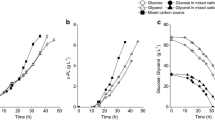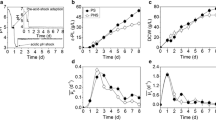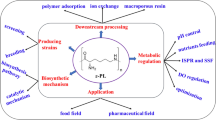Abstract
ε-Poly-l-lysine (ε-PL) is a natural food preservative, which exhibits antimicrobial activity against a wide spectra of microorganisms. The production of ε-PL was significantly enhanced by pH shock in our previous study, but the underlying mechanism is poorly understood. According to transcriptional and physiological analyses in this study, the mprA/B and pepD signal transduction system was first proved to be presented and activated in Streptomyces albulus M-Z18 by pH shock, which positively regulated the transcription of ε-PL synthetase (Pls) gene and enhanced the Pls activity during fermentation. Furthermore, pH shock changed the ratio of unsaturation to saturation fatty acid in the membrane through up-regulating the transcription of fatty acid desaturase genes (SAZ_RS14940, SAZ_RS14945). In addition, pH shock also enhanced the transcription of cytochrome c oxidase (SAZ_RS15070, SAZ_RS15075), ferredoxin reductase (SAZ_RS34975) and iron sulfur protein (SAZ_RS31410) genes, and finally resulted in the improvement of cell respiratory activity. As a result, pH shock was considered to influence a wide range of proteins including regulators, fatty acid desaturase, respiratory chain component, and ATP-binding cassette transporter during fermentation. These combined influences might contribute to enhanced ε-PL productivity with pH shock.







Similar content being viewed by others
References
Bankar SB, Singhal RS (2013) Panorama of poly-ε-lysine. Rsc Adv 3:8586–8603
Beney L, Gervais P (2001) Influence of the fluidity of the membrane on the response of microorganisms to environmental stresses. Appl Microbiol Biotechnol 57:34–42
Borst P, Zelcer N, Helvoort AV (2000) ABC transporters in lipid transport. Biochim Biophys Acta 1486:128–144
Broadbent JR, Larsen RL, Deibel V, Steele JL (2010) Physiological and transcriptional response of Lactobacillus casei ATCC 334 to acid stress. J Bacteriol 192:2445–2458
Chen X-S, Li S, Liao L-J, Ren X-D, Li F, Tang L, Zhang J-H, Mao Z-G (2011) Production of ε-poly-l-lysine using a novel two-stage pH control strategy by Streptomyces sp. M-Z18 from glycerol. Bioprocess Biosyst Eng 34:561–567
Chen X-S, Mao Z-G (2013) Comparison of glucose and glycerol as carbon sources for ε-poly-l-lysine production by Streptomyces sp. M-Z18. Appl Biochem Biotechnol 170:185–197
Chen X-S, Ren X-D, Zeng X, Zhao F-L, Tang L, Zhang H-J, Zhang J-H, Mao Z-G (2013) Enhancement of ε-poly-l-lysine production coupled with precursor l-lysine feeding in glucose–glycerol co-fermentation by Streptomyces sp. M-Z18. Bioprocess Biosyst Eng 36:1843–1849
Chen X, Tang L, Li S, Liao L, Zhang J, Mao Z (2011) Optimization of medium for enhancement of ε-poly-l-lysine production by Streptomyces sp. M-Z18 with glycerol as carbon source. Bioresour Technol 102:1727–1732
Foster JW (1991) Salmonella acid shock proteins are required for the adaptive acid tolerance response. J Bacteriol 173:6896–6902
Hayes A, Hobbs G, Smith CP, Oliver SG, Butler PR (1997) Environmental signals triggering methylenomycin production by Streptomyces coelicolor A3(2). J Bacteriol 179:5511–5515
He H, Hovey R, Kane J, Singh V, Zahrt TC (2006) MprAB is a stress-responsive two-component system that directly regulates expression of sigma factors SigB and SigE in Mycobacterium tuberculosis. J Bacteriol 188:2134
Hiraki J, Ichikawa T, Ninomiya S, Seki H, Uohama K, Seki H, Kimura S, Yanagimoto Y, Barnett JW Jr (2003) Use of ADME studies to confirm the safety of epsilon-polylysine as a preservative in food. Regul Toxicol Pharm 37:328–340
Huang R, Pan M, Wan C, Shah NP, Tao X, Wei H (2016) Physiological and transcriptional responses and cross protection of Lactobacillus plantarum ZDY2013 under acid stress. J Dairy Sci 99:1002–1010
Jiang J, Sun YF, Tang X, He CN, Shao YL, Tang YJ, Zhou WW (2017) Alkaline pH shock enhanced production of validamycin A in fermentation of Streptomyces hygroscopicus. Bioresour Technol 249:234
Kahar P, Iwata T, Hiraki J, Park EY, Okabe M (2001) Enhancement of ε-polylysine production by Streptomyces albulus strain 410 using pH control. J Biosci Bioeng 91:190–194
Kim YJ, Moon AN, Song JY, Kim ES, Kim CJ, Chang YK (2009) Gene-expression analysis of acidic pH shock effects on two-component systems in Streptomyces coelicolor. Biotechnol Bioprocess Eng 14:584
Kolbeck S, Behr J, Vogel RF, Ludwig C, Ehrmann MA (2019) Acid stress response of Staphylococcus xylosus elicits changes in the proteome and cellular membrane. J Appl Microbiol 126:1480–1495
Köster W (2001) ABC transporter-mediated uptake of iron, siderophores, heme and vitamin B12. Res Microbiol 152:291–301
Overbergh L, Giulietti A, Valckx D, Decallonne B, Bouillon R, Mathieu C (2003) The use of real-time reverse transcriptase PCR for the quantification of cytokine gene expression. J Biomol Tech 14:33–43
Lara AR, Leal L, Flores N, Gosset G, Bolívar F, Ramírez OT (2010) Transcriptional and metabolic response of recombinant Escherichia coli to spatial dissolved oxygen tension gradients simulated in a scale-down system. Biotechnol Bioeng 93:372–385
Li S, Li F, Chen X-S, Wang L, Xu J, Tang L, Mao Z-G (2012) Genome shuffling enhanced ε-poly-l-lysine production by improving glucose tolerance of Streptomyces graminearus. Appl Biochem Biotechnol 166:414–423
Liu S, Wu Q, Zhang J, Mo S (2011) Production of ε-poly-l-lysine by Streptomyces sp. using resin-based, in situ product removal. Biotechnol Lett 33:1581–1585
Michener JK, Jens N, Smolke CD (2012) Identification and treatment of heme depletion attributed to overexpression of a lineage of evolved P450 monooxygenases. Proc Natl Acad Sci USA 109:19504–19509
Mishra NK, Chang J, Zhao PX (2014) Prediction of membrane transport proteins and their substrate specificities using primary sequence information. PLoS One 9:e100278
Pan L, Chen X-S, Liu M-M, Liu Y-J, Mao Z-G (2017) Efficient production of ε-poly-l-lysine from glucose by two-stage fermentation using pH shock strategy. Process Biochem 63:8–15
Pang X, Vu P, Byrd TF, Ghanny S, Soteropoulos P, Mukamolova GV, Wu S, Samten B, Howard ST (2007) Evidence for complex interactions of stress-associated regulons in an mprAB deletion mutant of Mycobacterium tuberculosis. Microbiol 153:1229–1242
Ren X-D, Chen X-S, Tang L, Zeng X, Wang L, Mao Z-G (2015) Physiological mechanism of the overproduction of ε-poly-l-lysine by acidic pH shock in fed-batch fermentation. Bioprocess Biosyst Eng 38:2085–2094
Ren X-D, Chen X-S, Zeng X, Wang L, Tang L, Mao Z-G (2015) Acidic pH shock induced overproduction of ε-poly-l-lysine in fed-batch fermentation by Streptomyces sp. M-Z18 from agro-industrial by-products. Bioprocess Biosyst Eng 38:1113–1125
Riccardo M, Roberta P, Sebastien R, Jocelyn B, Luc G, Issar S, Roberta P (2004) Sigma factors and global gene regulation in Mycobacterium tuberculosis. J Bacteriol 186:895–902
Shih IL, Shen MH, Van YT (2006) Microbial synthesis of poly(epsilon-lysine) and its various applications. Bioresour Technol 97:1148–1159
Wang D, Yang C, Long D, Zhu J, Wang J, Zhang S (2015) Comparative transcriptome analyses of drought-resistant and—susceptible Brassica napus L. and development of EST-SSR markers by RNA-Seq. J Plant Biol 58:259–269
Wei ZH, Bai L, Deng Z, Zhong JJ (2012) Impact of nitrogen concentration on validamycin A production and related gene transcription in fermentation of Streptomyces hygroscopicus 5008. Bioprocess Biosyst Eng 35:1201–1208
White MJ, He H, Penoske RM, Twining SS, Zahrt TC (2010) PepD participates in the Mycobacterial stress response mediated through MprAB and SigE. J Bacteriol 192:1498
Xu D, Yao H, Xu Z, Wang R, Xu Z, Li S, Feng X, Liu Y, Xu H (2017) Production of ε-poly-lysine by Streptomyces albulus PD-1 via solid-state fermentation. Bioresour Technol 223:149–156
Xu Z, Feng X, Sun Z, Cao C, Li S, Xu Z, Xu Z, Bo F, Xu H (2015) Economic process to co-produce poly (ε-l-lysine) and poly (l-diaminopropionic acid) by a pH and dissolved oxygen control strategy. Bioresour Technol 187:70–76
Yamanaka K, Kito N, Imokawa Y, Maruyama C, Utagawa T, Hamano Y (2010) Mechanism of ε-poly-l-lysine production and accumulation revealed by identification and analysis of an ε-poly-l-lysine-degrading enzyme. Appl Environ Microbiol 76:5669–5675
Yoshida T, Nagasawa T (2003) ε-Poly-l-lysine: microbial production, biodegradation and application potential. Appl Microbiol Biotechnol 62:21–26
Zhang Y, Feng X, Xu H, Yao Z, Ouyang P (2010) ε-Poly-l-lysine production by immobilized cells of Kitasatospora sp. MY 5-36 in repeated fed-batch cultures. Bioresour Technol 101:5523–5527
Acknowledgements
This work was supported by the Program of the National Natural Science Foundation of China (31671846, 31301556), and the National First-Class Discipline Program of Light Industry Technology and Engineering (LITE2018-27), the Cooperation Project of Jiangsu Province among Industries, Universities and Institutes (BY2016022-25).
Author information
Authors and Affiliations
Corresponding authors
Ethics declarations
Conflicts of interest
The authors declare that they have no conflict of interests.
Additional information
Publisher's Note
Springer Nature remains neutral with regard to jurisdictional claims in published maps and institutional affiliations.
Electronic supplementary material
Below is the link to the electronic supplementary material.
Rights and permissions
About this article
Cite this article
Pan, L., Chen, X., Wang, K. et al. Understanding high ε-poly-l-lysine production by Streptomyces albulus using pH shock strategy in the level of transcriptomics. J Ind Microbiol Biotechnol 46, 1781–1792 (2019). https://doi.org/10.1007/s10295-019-02240-z
Received:
Accepted:
Published:
Issue Date:
DOI: https://doi.org/10.1007/s10295-019-02240-z




